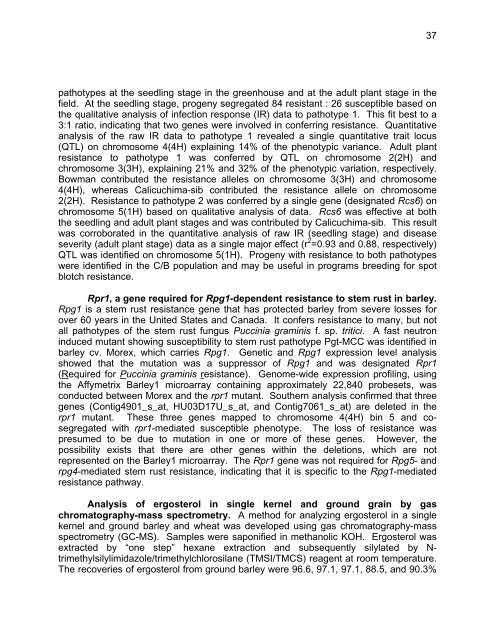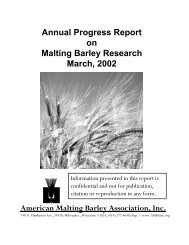Annual Progress Report on Malting Barley Research March, 2007
Annual Progress Report on Malting Barley Research March, 2007
Annual Progress Report on Malting Barley Research March, 2007
You also want an ePaper? Increase the reach of your titles
YUMPU automatically turns print PDFs into web optimized ePapers that Google loves.
pathotypes at the seedling stage in the greenhouse and at the adult plant stage in the<br />
field. At the seedling stage, progeny segregated 84 resistant : 26 susceptible based <strong>on</strong><br />
the qualitative analysis of infecti<strong>on</strong> resp<strong>on</strong>se (IR) data to pathotype 1. This fit best to a<br />
3:1 ratio, indicating that two genes were involved in c<strong>on</strong>ferring resistance. Quantitative<br />
analysis of the raw IR data to pathotype 1 revealed a single quantitative trait locus<br />
(QTL) <strong>on</strong> chromosome 4(4H) explaining 14% of the phenotypic variance. Adult plant<br />
resistance to pathotype 1 was c<strong>on</strong>ferred by QTL <strong>on</strong> chromosome 2(2H) and<br />
chromosome 3(3H), explaining 21% and 32% of the phenotypic variati<strong>on</strong>, respectively.<br />
Bowman c<strong>on</strong>tributed the resistance alleles <strong>on</strong> chromosome 3(3H) and chromosome<br />
4(4H), whereas Calicuchima-sib c<strong>on</strong>tributed the resistance allele <strong>on</strong> chromosome<br />
2(2H). Resistance to pathotype 2 was c<strong>on</strong>ferred by a single gene (designated Rcs6) <strong>on</strong><br />
chromosome 5(1H) based <strong>on</strong> qualitative analysis of data. Rcs6 was effective at both<br />
the seedling and adult plant stages and was c<strong>on</strong>tributed by Calicuchima-sib. This result<br />
was corroborated in the quantitative analysis of raw IR (seedling stage) and disease<br />
severity (adult plant stage) data as a single major effect (r 2 =0.93 and 0.88, respectively)<br />
QTL was identified <strong>on</strong> chromosome 5(1H). Progeny with resistance to both pathotypes<br />
were identified in the C/B populati<strong>on</strong> and may be useful in programs breeding for spot<br />
blotch resistance.<br />
Rpr1, a gene required for Rpg1-dependent resistance to stem rust in barley.<br />
Rpg1 is a stem rust resistance gene that has protected barley from severe losses for<br />
over 60 years in the United States and Canada. It c<strong>on</strong>fers resistance to many, but not<br />
all pathotypes of the stem rust fungus Puccinia graminis f. sp. tritici. A fast neutr<strong>on</strong><br />
induced mutant showing susceptibility to stem rust pathotype Pgt-MCC was identified in<br />
barley cv. Morex, which carries Rpg1. Genetic and Rpg1 expressi<strong>on</strong> level analysis<br />
showed that the mutati<strong>on</strong> was a suppressor of Rpg1 and was designated Rpr1<br />
(Required for Puccinia graminis resistance). Genome-wide expressi<strong>on</strong> profiling, using<br />
the Affymetrix <strong>Barley</strong>1 microarray c<strong>on</strong>taining approximately 22,840 probesets, was<br />
c<strong>on</strong>ducted between Morex and the rpr1 mutant. Southern analysis c<strong>on</strong>firmed that three<br />
genes (C<strong>on</strong>tig4901_s_at, HU03D17U_s_at, and C<strong>on</strong>tig7061_s_at) are deleted in the<br />
rpr1 mutant. These three genes mapped to chromosome 4(4H) bin 5 and cosegregated<br />
with rpr1-mediated susceptible phenotype. The loss of resistance was<br />
presumed to be due to mutati<strong>on</strong> in <strong>on</strong>e or more of these genes. However, the<br />
possibility exists that there are other genes within the deleti<strong>on</strong>s, which are not<br />
represented <strong>on</strong> the <strong>Barley</strong>1 microarray. The Rpr1 gene was not required for Rpg5- and<br />
rpg4-mediated stem rust resistance, indicating that it is specific to the Rpg1-mediated<br />
resistance pathway.<br />
Analysis of ergosterol in single kernel and ground grain by gas<br />
chromatography-mass spectrometry. A method for analyzing ergosterol in a single<br />
kernel and ground barley and wheat was developed using gas chromatography-mass<br />
spectrometry (GC-MS). Samples were sap<strong>on</strong>ified in methanolic KOH. Ergosterol was<br />
extracted by “<strong>on</strong>e step” hexane extracti<strong>on</strong> and subsequently silylated by Ntrimethylsilylimidazole/trimethylchlorosilane<br />
(TMSI/TMCS) reagent at room temperature.<br />
The recoveries of ergosterol from ground barley were 96.6, 97.1, 97.1, 88.5, and 90.3%<br />
37
















